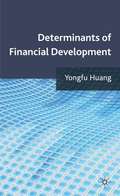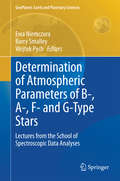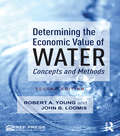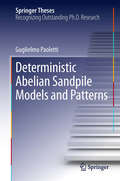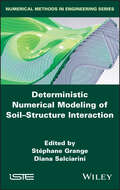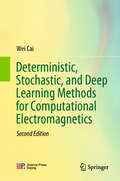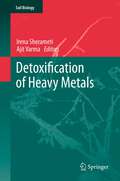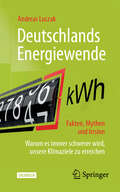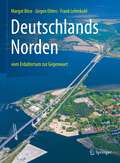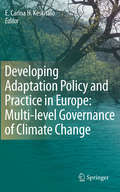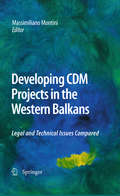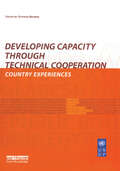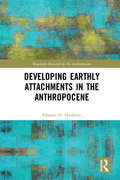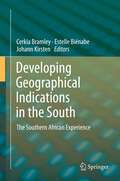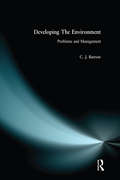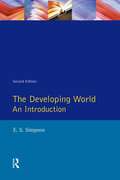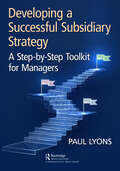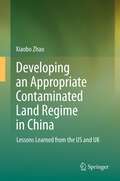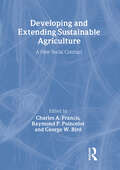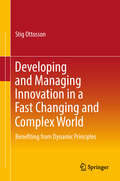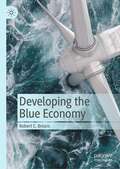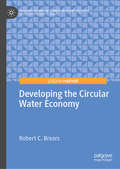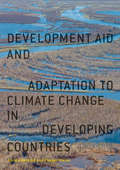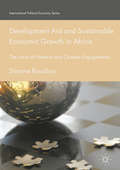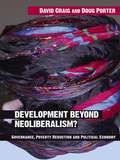- Table View
- List View
Determinants of Financial Development
by Yongfu HuangA PDF version of this book is available for free in open access via the OAPEN Library platform, www. oapen. org. This book examines the emergence of both financial markets and carbon markets, and provides an in-depth investigation on the fundamental determinants of financial development.
Determination of Atmospheric Parameters of B-, A-, F- and G-Type Stars
by Ewa Niemczura Barry Smalley Wojtek PychThis book introduces the theory of stellar atmospheres. Almost everything we know about stars is by analysis of the radiation coming from their atmospheres. Several aspects of astrophysics require accurate atmospheric parameters and abundances. Spectroscopy is one of the most powerful tools at an astronomer's disposal, allowing the determination of the fundamental parameters of stars: surface temperature, gravity, chemical composition, magnetic field, rotation and turbulence. These can be supplemented by distance measurements or pulsation parameters providing information about stellar interior and stellar evolution, otherwise unavailable. The volume is based on lectures presented at the Wrocław's Spectroscopic School aimed at training young researchers in performing quantitative spectral analysis of low-, mid-, and high-resolution spectra of B, A, and F-type stars.
Determining the Economic Value of Water: Concepts and Methods
by Robert A. Young John B. LoomisWater provides benefits as a commodity for agriculture, industry, and households, and as a public good such as fisheries habitat, water quality and recreational use. To aid in cost-benefit analysis under conditions where market determined price signals are usually unavailable, economists have developed a range of alternative valuation methods for measuring economic benefits. This volume provides the most comprehensive exposition to-date of the application of economic valuation methods to proposed water resources investments and policies. It provides a conceptual framework for valuation of both commodity and public good uses of water, addressing non-market valuation techniques appropriate to measuring public benefits - including water quality improvement, recreation, and fish habitat enhancement. The book describes the various measurement methods, illustrates how they are applied in practice, and discusses their strengths, limitations, and appropriate roles. In this second edition, all chapters have been thoroughly updated, and in particular the coverage of water markets and valuation of ecosystem services from water has been expanded. Robert Young, author of the 2005 edition, has been joined for this new edition by John Loomis, who brings additional expertise on ecosystem services and the environmental economics of water for recreational and other public good uses of water.
Deterministic Abelian Sandpile Models and Patterns
by Guglielmo PaolettiThe model investigated in this work, a particular cellular automaton with stochastic evolution, was introduced as the simplest case of self-organized-criticality, that is, a dynamical system which shows algebraic long-range correlations without any tuning of parameters. The author derives exact results which are potentially also interesting outside the area of critical phenomena. Exact means also site-by-site and not only ensemble average or coarse graining. Very complex and amazingly beautiful periodic patterns are often generated by the dynamics involved, especially in deterministic protocols in which the sand is added at chosen sites. For example, the author studies the appearance of allometric structures, that is, patterns which grow in the same way in their whole body, and not only near their boundaries, as commonly occurs. The local conservation laws which govern the evolution of these patterns are also presented. This work has already attracted interest, not only in non-equilibrium statistical mechanics, but also in mathematics, both in probability and in combinatorics. There are also interesting connections with number theory. Lastly, it also poses new questions about an old subject. As such, it will be of interest to computer practitioners, demonstrating the simplicity with which charming patterns can be obtained, as well as to researchers working in many other areas.
Deterministic Numerical Modeling of Soil Structure Interaction
by Diana Salciarini Stéphane GrangeIn order to describe soil–structure interaction in various situations (nonlinear, static, dynamic, hydro-mechanical couplings), this book gives an overview of the main modeling methods developed in geotechnical engineering. The chapters are centered around: the finite element method (FEM), the finite difference method (FDM), and the discrete element method (DEM). Deterministic Numerical Modeling of Soil–Structure Interaction allows the reader to explore the classical and well-known FEM and FDM, using interface and contact elements available for coupled hydro-mechanical problems.Furthermore, this book provides insight on the DEM, adapted for interaction laws at the grain level. Within a classical finite element framework, the concept of macro-element is introduced, which generalizes constitutive laws of SSI and is particularly straightforward in dynamic situations. Finally, this book presents the SSI, in the case of a group of structures, such as buildings in a town, using the notion of metamaterials and a geophysics approach.
Deterministic, Stochastic, and Deep Learning Methods for Computational Electromagnetics
by Wei CaiThis book provides a well-balanced and comprehensive picture based on clear physics, solid mathematical formulation, and state-of-the-art useful numerical methods in deterministic, stochastic, deep neural network machine learning approaches for computer simulations of electromagnetic and transport processes in biology, microwave and optical wave devices, and nano-electronics. Computational research has become strongly influenced by interactions from many different areas including biology, physics, chemistry, engineering, etc. A multifaceted approach addressing the interconnection among mathematical algorithms and physical foundation and application is much needed to prepare graduate students and researchers in applied mathematics and sciences and engineering for innovative advanced computational research in many applications areas, such as biomolecular solvation in solvents, radar wave scattering, the interaction of lights with plasmonic materials, plasma physics, quantum dots, electronic structure, current flows in nano-electronics, and microchip designs, etc.
Detoxification of Heavy Metals
by Ajit Varma Irena SherametiHeavy metals are severe environmental pollutants, and many of them are toxic even at very low concentrations. With industrial development, soil pollution with heavy metal elements have dramatically increased. The uptake of heavy metals via plants that are exposed to contaminated soils is a risk for human health and a major hazard for the ecosystem as a whole, including soil microorganisms. On the other hand, plants may be used in the decontamination of soils. The topics presented in this book include: sources of heavy metals contaminants in soils; plant species that can grow on contaminated soils; the phytoremediation of contaminated soils; tolerance, accumulation and detoxification mechanisms of zinc, copper, arsenic, cadmium and vanadium in plants; the critical role of sulfur metabolism in heavy metal tolerance; the role of aquatic macrophytes, plant growth-promoting bacteria, sugar crops and earthworms in detoxification; and heavy metal stabilization by promoting zeolite synthesis in soils.
Deutschlands Energiewende – Fakten, Mythen und Irrsinn: Warum es immer schwerer wird, unsere Klimaziele zu erreichen
by Andreas LuczakSchon mehrere Jahrzehnte arbeitet Deutschland an der Energiewende, aber trotz gigantischer Kosten gehen die Treibhausgasemissionen viel zu langsam zurück. Bei diesem „Tempo“ wird die Klimaneutralität erst im nächsten Jahrhundert erreicht. Eine ausführliche Betrachtung der Thematik aus verschiedenen Perspektiven macht deutlich, dass die Energiewende nur ganzheitlich diskutiert werden kann und ein polarisierendes „schwarz-weiß-Denken“ uns nicht weiterbringt. Das Buch möchte eine Orientierung in dem komplexen Umfeld der Energiewende bieten und liefert Antworten auf Fragen wie diese: Welche Folgen hat die Energiewende für Deutschland? Wie sinnvoll sind Elektromobilität und Wasserstoffspeicher wirklich? Ist die Politik für Klimaschutz verantwortlich oder rettet nur persönlicher Verzicht das Klima? Die 2., aktualisierte Auflage.
Deutschlands Norden: vom Erdaltertum zur Gegenwart
by Margot Böse Jürgen Ehlers Frank LehmkuhlDieses Sachbuch erklärt die faszinierende Entstehung der heutigen Landschaft im Norden Deutschlands. Das Ziel ist es, in einer integrativen Betrachtungsweise geowissenschaftliche, archäologische und ökologische Forschungsergebnisse zusammen zu führen und vielfältige Veränderungen des Naturraumes durch den Menschen darzustellen. Für die neue Auflage wurden daher etliche Kapitel grundlegend überarbeitet und ergänzt und es wurden neue, spannende Exkurse eingefügt. Im ersten Teil beschreiben die Autoren die Geologie des Untergrundes und die später durch den Menschen genutzten Rohstoffe, vornehmlich Salze und Kohle. Auch die Klimageschichte spielt eine wichtige Rolle bei der Landschaftsentwicklung, daher werden dem Leser einige gängige Forschungsmethoden für die eiszeitlichen und nacheiszeitlichen Klimaveränderungen vorgestellt. Im nächsten Teil des Buches wird auf die verschiedenen rezenten Natur- und Landschaftsräume mit ihren spezifischen Oberflächenformen eingegangen: die unterschiedlichen Küsten von Nordsee und Ostsee, die ehemals vergletscherten Moränenlandschaften der quartären Vereisungen, die Mittelgebirge Harz und Eifel und die großen Flusssysteme. Am Ende des Buches zeigen die Autoren auf, wie der Mensch die Landschaft in den letzten 7.500 Jahren genutzt und damit umgestaltet hat. Abschließend wird ein Überblick über die aktuellen Maßnahmen zum Schutz der Landschaft und zum Erhalt der ökologischen Vielfalt gegeben. Das reich bebilderte, anschauliche und zum Stöbern einladende Buch ist eine erweiterte und ergänzte Auflage und liefert mit seinen Schwerpunkten: · Einen tiefen Einblick in die spannende Geschichte der Landschaft im Norden Deutschlands. · Eine fundierte Beschreibung der einzelnen Landschaftsräume und deren Entstehung. · Aktuelle Forschung zur Prägung und immer weiter zunehmenden Veränderung der Umwelt durch den Menschen seit Beginn der Jungsteinzeit. Als Leser möchten wir Studierende, Lehrende und aber auch gerade interessierte Laien gewinnen, die sich für Norddeutschland als Natur- und Kulturraum interessieren. Daher ist das Buch sprachlich so abgefasst, dass es einen breiten Leserkreis anspricht.
Developing Adaptation Policy and Practice in Europe: Multi-level Governance of Climate Change
by E. Carina KeskitaloMitigation will not be sufficient for us to avoid climate change and we will need to adapt to its consequences. This book targets the development of adaptation policy in European countries with different relations between central and regional/local government.
Developing CDM Projects in the Western Balkans
by Massimiliano MontiniDeveloping CDM Projects in the Western Balkans: Legal and Technical Issues Compared, arises from the professional practical experience gained by an interdisciplinary team of legal and technical experts acting in the framework of the environmental bilateral cooperation performed by the Italian Ministry for the Environment, Land and Sea in the Western Balkan countries, through the "Task Force for Central and Eastern Europe". The added value of the book consists in the fact that it jointly presents the real professional experience gained by a multi sectoral team of lawyers, economists, engineers and other technical experts, working in synergy with a shared vision. This volume will be useful not only to those specifically interested in the Western Balkan area, but represents a broader example of lessons learned in the development of CDM projects. Therefore, it may have a broad market among Government officials and legal-economic-technical professionals dealing with climate change issues as well as academics developing scientific research in this field.
Developing Capacity Through Technical Cooperation: Country Experiences
by Stephen BrowneTechnical co-operation involving northern experts transferring expertise to the south has not always worked. In fact it has sometimes been counter-productive, fostering a dependency on outside help rather than creating a genuine indigenous capability. This study by experts from Harvard University and the UN Development Programme (UNDP) uses a range of country studies to analyze what has worked in the past, what hasn't, and how to ensure that future co-operation results in genuine capacity building and ownership of the new capabilities by the recipients. It aims to offer a framework for evaluating different methods to achieve these goals. The volume is a companion to the earlier Capacity for Development, and should be useful for all those working in international development, as well as researchers, academics and students.
Developing Earthly Attachments in the Anthropocene (Routledge Research in the Anthropocene)
by Edward H. HuijbensThis book explores the development and significance of an Earth-oriented progressive approach to fostering global wellbeing and inclusive societies in an era of climate change and uncertainty. Developing Earthly Attachments in the Anthropocene examines the ways in which the Earth has become a source of political, social, and cultural theory in times of global climate change. The book explains how the Earth contributes to the creation of a regenerative culture, drawing examples from the Netherlands and Iceland. These examples offer understandings of how legacies of non-respectful exploitative practices culminating in the rapid post-war growth of global consumption have resulted in impacts on the ecosystem, highlighting the challenges of living with planet Earth. The book familiarizes readers with the implied agencies of the Earth which become evident in our reliance on the carbon economy – a factor of modern-day globalized capitalism responsible for global environmental change and emergency. It also suggests ways to inspire and develop new ways of spatial sense making for those seeking earthly attachments. Offering novel theoretical and practical insights for politically active people, this book will appeal to those involved in local and national policy making processes. It will also be of interest to academics and students of geography, political science, and environmental sciences.
Developing Geographical Indications in the South: The Southern African Experience
by Cerkia Bramley Estelle Bienabe Johann KirstenThis book contributes to the literature on Geographical Indications (GIs) by providing key theoretical reflections from a five-year review process on the potential of GIs for agri-food products in Southern Africa. The contributors reflect on diverse GI processes and dynamics which operate at the local, national and international levels, thus enriching the understanding of GI dynamics and of the variety of policy options available for GI protection in Southern countries. Following a discussion of the legal framework and governance of national GI schemes in Southern countries, the book emphasizes the main dimensions underlying the development of GIs and their potential for enhancing sustainable rural development and market access in particular. This provides the structure for the chapters that build on the different experiences of Southern African industries that have embarked on GI strategies. The book includes chapters on designing an appropriate legal framework and governance system for the development of GIs in Southern countries.
Developing The Environment: Problems & Management
by C J BarrowThis book presents a comprehensive overview of global environmental problems - past, present and future - examining their roots and implications and suggesting, where possible, ways in which they might be mitigated or avoided by careful management.
Developing World, The: An Introduction
by E. S. SimpsonAddresses the issues faced by developing nations in attempting to secure sustainable economic development.
Developing a Successful Subsidiary Strategy: A Step-by-Step Toolkit for Managers
by Paul LyonsMost books on business strategy approach the subject from a corporate perspective – covering topics such as the vision for the business, the marketplace, competition, differentiation etc. However, the reality is that most managers work in sub-units or subsidiaries of the business and they are not involved in corporate strategy formulation. Their strategic concerns are with the positioning and future trajectory of their own units within the complex internal ecosystem in which they exist. If these units are to survive and grow, the middle managers responsible for them must plan their future, maximize their value-add, and compete for resources within the internal market of their corporations. Such internal markets are becoming increasingly volatile due to general economic conditions, but also given the questioning of globalization and increasing corporate concerns about the frailties of international supply chains as brought into sharp focus by the Covid-19 crisis and the war in Ukraine. This book provides practical perspectives for these business unit managers, and a step-by-step toolkit that can be used by management teams to develop a successful subsidiary strategy that acknowledges these challenges while maximizing their contribution to corporate objectives. It is based on the authors 30 years of experience as an executive in a complex multinational (IBM) organization, supplemented by academic study at Masters and PhD level. The material covered has been verified through workshops over a 3-year period with the senior leadership teams of 25 multinational subsidiaries operating from Ireland.
Developing an Appropriate Contaminated Land Regime in China
by Xiaobo ZhaoLike all industrialized countries, China has encountered increasing problems with land contamination in recent years. Abandoned mining and manufacturing sites and obsolete industrial complexes, while also creating new polluting industrial enterprises, represent impending environmental threats. More importantly, a number of social and economic problems have developed and must be dealt with, in some cases urgently. Contaminated land laws and regulations have been established and have evolved in the US and UK and many other jurisdictions over the past few decades. These regimes have substantially influenced the relevant legislation in the context of numerous Asian and European countries and will inevitably benefit similar legislative efforts in China. This book is the first monograph that focuses on how China can learn from the US and UK with respect to contaminated land legislation and comprehensively illustrates how contaminated land law could be created in China. It will be of interest to academics and practitioners in environmental law in China, as well as the US and UK.
Developing and Extending Sustainable Agriculture: A New Social Contract
by Charles A. Francis George W. Bird Raymond P. PoincelotGet the latest sustainable agriculture practices and keep an eye on the future Developing and Extending Sustainable Agriculture: A New Social Contract explores the challenges faced by today’s farmers and ranchers to provide practical strategies to develop a twenty-first century system of sustainable agriculture that is economically sound, environmentally compatible, and socially acceptable. This comprehensive look at the current state of farming and ranching presents leading authorities discussing concepts and approaches in sustainable agriculture such as crop rotations, integrated pest management, alternative sources of nutrients to maintain productivity, and rotational grazing systems.Presently there is a trend toward a more industrial agriculture and a global food system that will bring long-term negative impacts. If farmers look thoughtfully toward the future, alternatives are now available to help solve these problems to provide agricultural sustainability for generations to come. Developing and Extending Sustainable Agriculture: A New Social Contract provides a model for integrated research and outreach to everyone interested in sustainable development. A sensible framework of practical short-term strategies are combined with visionary long-term plans to provide viable approaches to sustain agriculture, secure our food system, and develop a more equitable society for the future. The text includes several tables and figures, extensive references, and comprehensive bibliographies.Topics in Developing and Extending Sustainable Agriculture: A New Social Contract include: the evolution of the concept of equitable and sustainable development on-farm research farmer to farmer education IPM (integrated pest management) soil management managed grazing whole-farm planning, including economic analysis training for sustainable agriculture motivation theory and research to foster positive sustainable development organic farming productivity the future of sustainable agriculture much, much more Developing and Extending Sustainable Agriculture: A New Social Contract is enlightening, horizon-expanding reading perfect for educators, students, government decision makers, cooperative extension educators, specialists, administrators, citizen members of county extension boards, and administrators in land grant universities.
Developing and Managing Innovation in a Fast Changing and Complex World: Benefiting from Dynamic Principles
by Stig OttossonThis book provides essential insights into how to rapidly and safely develop new sustainable products, no matter whether it is in the private sector, the public sector or the non-profit sector, and regardless of the specific national or business culture.The principles discussed were distilled from experiences and insights gained in numerous practical innovation endeavors, and from insider action research in connection with ongoing development, change management, and innovation projects in various areas and branches of the business world and non-commercial sector.In short, the practical work and research has revealed that, regardless of the specific product and/or business to be developed, clear advantages can be gained by using dynamic or agile methods based on modern theories. These advantages include: reduced risk of failure, shorter time to market, less money and effort spent, better outcome solutions, etc. than when classical methods are used. Accordingly, the book also highlights the differences between the classical/traditional and dynamic mindset and approaches. It offers suggestions on how to think, organize, lead, and act in order to excel in an increasingly complex and non-linear world. The more you can assimilate the theories, principles and methods – and integrate them in the culture you operate in – the greater the benefits will be for you and your organization.
Developing the Blue Economy
by Robert C. BrearsTraditionally, the ocean economy is viewed solely as a mechanism for economic growth. In this business-as-usual approach, large-scale industrial economies have developed the ocean economy through the exploitation of maritime and marine resources, often without consideration of how those activities impact the future health or productivity of those same resources. This has led to aquatic ecosystems being viewed and treated as limitless resources; the marine environment becoming a dumping ground for waste; overfishing diminishing fishing stocks; ocean habitats being degraded from coastal developments; sea-level rise impacting coastal communities and infrastructure; increasing ocean acidification; and the marginalisation of poor coastal communities.Recognising the failings of the traditional ocean economy, there is a transition underway around the world towards the Blue Economy. This concept moves beyond the business-as-usual approach with economic development and ocean health complementary to one another. In the Blue Economy, the environmental risks of and ecological degradation from economic activity are mitigated or significantly reduced. Therefore, economic activity is in balance with the long-term capacity of the ocean ecosystems to support this activity and remain healthy and resilient. This book will provide an overview of the various technologies used to promote cross-sectoral and multi-scalar collaboration, facilitate the integrated management of sectors and resources, foster partnerships between governments and industry, encourage R&D in new technologies in resource use and management, and scale-up innovative financing mechanisms in the development of a Blue Economy. Also, the book will contain in-depth case studies that illustrate how locations, of differing climates, lifestyles and income levels, have implemented technologies to facilitate the development of the Blue Economy.Developing the Blue Economy will provide an accessible resource for practitioners and researchers working in the field on the various innovative technologies being implemented around the world to create a Blue Economy.
Developing the Circular Water Economy (Palgrave Studies in Climate Resilient Societies)
by Robert C. BrearsThis book presents new research on policy innovations that promote the development of the circular water economy. In contrast to the linear economy, the circular water economy promotes the reduction of water consumption, reuse of water, and recovery of resources from wastewater to not only increase resilience to climate change but also to reduce greenhouse gas emissions resulting from the provision of water and wastewater-related services. Providing a series of in-depth case studies of important locations in differing climates around the globe that have implemented a variety of policy innovations to develop the circular water economy, this book is a valuable resource for water and resource conservation managers, policymakers, international companies and organisations interested in the circular economy, environmental NGOs, researchers, as well as graduate and undergraduate students. · Systematically reviews policy innovations to develop the circular water economy· Illustrates how leading locations from around the world have developed the circular water economy to increase resilience to climate change while reducing emissions · Provides ‘best practices’ for other locations around the world aiming to implement the circular water economy
Development Aid and Adaptation to Climate Change in Developing Countries
by Carola Betzold Florian WeilerThis book examines development aid for climate change adaptation. Increasing amounts of aid are used to help developing countries adapt to climate change. The authors seek to discover how this aid is distributed and what constitutes the patterns of adaptation-aid giving. Does it help vulnerable countries, as donors promise, or does it help donors achieve economic and political gains? Set against the backdrop of international climate change negotiations and the aid allocation literature, Betzold and Weiler's empirical analysis proceeds in three steps: firstly they assess adaptation aid as reported by the OECD, then statistically examine patterns in adaptation aid allocation, and finally qualitatively investigate adaptation aid in three large climate donors: Germany, Sweden and the United Kingdom. With its mixed-method research design and comprehensive data, this work provides a unique, state-of-the-art analysis of adaptation aid as a new stream of development aid.
Development Aid and Sustainable Economic Growth in Africa
by Simone RaudinoThis book offers an original analysis of the long-term impact of western and Chinese economic and development cooperation policies in Africa. It argues that western Official Development Assistance (ODA) has failed to create viable and autonomous economies in beneficiary countries not (only) because of corruption, inefficiencies and cultural differences, but because it was never meant to do so. Raudino demonstrates, rather, that it was always designed to provide relief measures and nurture political relations rather than create genuinely industrialized and self-reliant economies. Similarly, by analyzing the nature of Chinese economic investments in Africa the author shows that China's governmental policies hardly represent a revolutionary departure from the cooperation standards set by the West. In making these observations he also taps into the broader question of why wealth continues to be generated unequally across the world. Based on extensive fieldwork, quantitative economic analysis and historical qualitative research, this thought-provoking work will appeal to students and scholars of politics, economics and development studies, as well as to those involved more directly in the aid process.
Development Beyond Neoliberalism?: Governance, Poverty Reduction and Political Economy
by David Alan Craig Doug PorterDevelopment’s current focus – poverty reduction and good governance – signals a turn away from the older neoliberal preoccupation with structural adjustment, privatization and downsizing the state. For some, the new emphases on empowering and securing the poor through basic service delivery, local partnership, decentralization and institution building constitute a decisive break with the past and a whole set of new development possibilities beyond neoliberalism. Taking a wider historical perspective, this book charts the emergence of poverty reduction and governance at the centre of development. It shows that the Poverty Reduction paradigm does indeed mark a shift in the wider liberal project that has underpinned development: precisely what is new, and what this means for how the poor are governed, are described here in detail. This book provides a compelling history of development doctrine and practice, and in particular offers the first comprehensive account of the last twenty years, and development’s shift towards a new political economy of institution building, decentralized governance and local partnerships. The story is illustrated with extensive case studies from first hand experience in Vietnam, Uganda, Pakistan and New Zealand.
